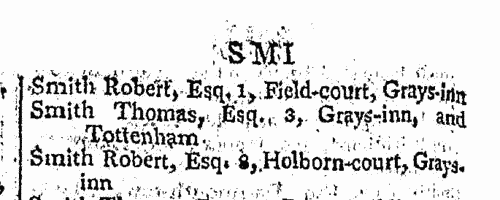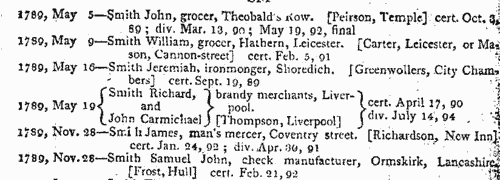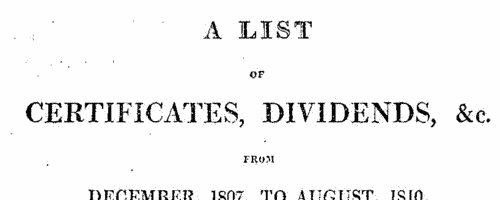Ballantyne Surname Ancestry ResultsOur indexes 1000-1999 include entries for the spelling 'ballantyne'. In the period you have requested, we have the following 219 records (displaying 21 to 30): Single Surname Subscription | | | Buying all 219 results of this search individually would cost £1,188.00. But you can have free access to all 219 records for a year, to view, to save and print, for £100. Save £1,088.00. More... |
These sample scans are from the original record. You will get scans of the full pages or articles where the surname you searched for has been found. Your web browser may prevent the sample windows from opening; in this case please change your browser settings to allow pop-up windows from this site.  Apprentices registered in Scotland
(1793) Apprentices registered in Scotland
(1793)
Apprenticeship indentures and clerks' articles were subject to a 6d or 12d per pound stamp duty: the registers of the payments usually give the master's trade, address, and occupation, and the apprentice's name, as well as details of the date and length of the apprenticeship. There are central registers for collections of the stamp duty in London, as well as returns from collectors in the provinces. The indentures themselves can date from a year or two earlier than this return. (The sample entry shown on this scan is taken from a Bristol return. Each entry has two scans, the other being the facing page with the details of the indenture, length of service, and payment of duty.) IR 1/66BALLANTYNE. Cost: £8.00.  | Sample scan, click to enlarge

|  Masters of apprentices registered in Scotland
(1797) Masters of apprentices registered in Scotland
(1797)
Apprenticeship indentures and clerks' articles were subject to a 6d or 12d per pound stamp duty: the registers of the payments usually give the master's trade, address, and occupation, and the apprentice's name, as well as details of the date and length of the apprenticeship. There are central registers for collections of the stamp duty in London, as well as returns from collectors in the provinces. The indentures themselves can date from a year or two earlier than this return. (The sample entry shown on this scan is taken from a Bristol return. Each entry has two scans, the other being the facing page with the details of the indenture, length of service, and payment of duty.) IR 1/68BALLANTYNE. Cost: £8.00.  | Sample scan, click to enlarge

|  Apprentices registered in Scotland
(1799) Apprentices registered in Scotland
(1799)
Apprenticeship indentures and clerks' articles were subject to a 6d or 12d per pound stamp duty: the registers of the payments usually give the master's trade, address, and occupation, and the apprentice's name, as well as details of the date and length of the apprenticeship. There are central registers for collections of the stamp duty in London, as well as returns from collectors in the provinces. These collectors generally received duty just from their own county, but sometimes from further afield. The indentures themselves can date from a year or two earlier than this return. (The sample entry shown on this scan is taken from a Bristol return. Each entry has two scans, the other being the facing page with the details of the indenture, length of service, and payment of duty.) IR 1/69BALLANTYNE. Cost: £8.00.  | Sample scan, click to enlarge

| Inhabitants of London
(1805)
Holden's Triennial Directory for 1805 to 1807 includes this 'London Alphabet. Private Residences'. About 10,000 people are recorded.BALLANTYNE. Cost: £4.00.  | Sample scan, click to enlarge

| Traders and professionals in London
(1805)
Holden's Triennial Directory for 1805 to 1807 includes this 'London Alphabet of Businesses, Professions, &c.': coverage is good; about 30,000 individuals are recorded.BALLANTYNE. Cost: £4.00.  | Sample scan, click to enlarge

| Bankrupts
(1786-1806)
William Smith's abstracts of bankrupts, dividends and certificates for England and Wales from 1786 to June 1806. Bankruptcy causes abrupt changes in people's lives, and is often the reason for someone appearing suddenly in a different location or in a different occupation.BALLANTYNE. Cost: £4.00.  | Sample scan, click to enlarge

| Subscribers to Felicia Dorothea Browne's Poems
(1808)
Poems, by Felicia Dorothea Browne, published in Liverpool in 1808, attracted a wide subscription list, headed by His Royal Highness the Prince of Wales, His Royal Highness the Duke of Gloucester, and Her Royal Highness the Princess Sophia of Gloucester. Although most of the subscribers were from London or Liverpool, there are many from elsewhere in the country. The names are arranged by initial letter of surname, each letter being headed by the names of nobility; christian names are rare, most surnames being prefixed by Mr., Mrs. or Miss. Many names are given addresses, or at least general locations, in italics. BALLANTYNE. Cost: £4.00.  | Sample scan, click to enlarge

| Bankrupts: Dividends and Certificates
(1807-1810)
William Smith's abstracts of bankruptcy certificates and dividends for England and Wales from December 1807 to 1810, referring to commissions taken out before December 1807. Each entry gives the year of the commission; the full name of the bankrupt, address, occupation, and the dates of dividends and certificate as appropriate. BALLANTYNE. Cost: £4.00.  | Sample scan, click to enlarge

| London Traders
(1814)
The fifteenth edition of The Post-Office Annual Directory includes this 'List of More than 17,000 Merchants, Traders, &c. of London, and Parts Adjacent', arranged alphabetically by surname, with trade in italics, and address.BALLANTYNE. Cost: £4.00.  | Sample scan, click to enlarge

| The Scotch Greys at Waterloo
(1815)
The muster roll of the officers and men of the 2nd or Royal North British Regiment of Dragoons who fought at Waterloo, 18 June 1815, and survived. Those wounded have 'w.' placed after their name. The 1st, 2nd and 6th Dragoons formed the second brigade of cavalry under Major-General Sir William Ponsonby (killed in action); the cavalry as a whole being commanded by Lieutenant-General the Earl of Uxbridge (wounded). The 2nd Dragoons (Scotch Greys) amounted to 391 men, under Lieutenant-Colonel J. I. Hamilton (killed in action). 'The Royal Dragoons, the Scotch Greys, and Inniskillings, General Ponsonby at their head, dispersed the enemy to a great distance, and precipitated themselves with unexampled boldness on the batteries at the right of the 1 corps, put the cannoneers to the sword and dismounted 30 pieces. But the cuirassiers of Lt. Gen. Milhaud, having advanced towards the chaussee to support the attack of infantry which had failed, the brigade of G. M. Travere from one side, and the 4th regiment of Lancers coming from the other, fell at the same time on these brave dragoons, who, not being able to resist this terrible shock, were cut to pieces and repulsed with considerable loss. The brave General Ponsonby was killed by the Lancers, boldly attempting to join the greater body of his brigade, from which he found himself separated.'BALLANTYNE. Cost: £6.00.  | Sample scan, click to enlarge

|
Research your ancestry, family history, genealogy and one-name study by direct access to original records and archives indexed by surname.
|













